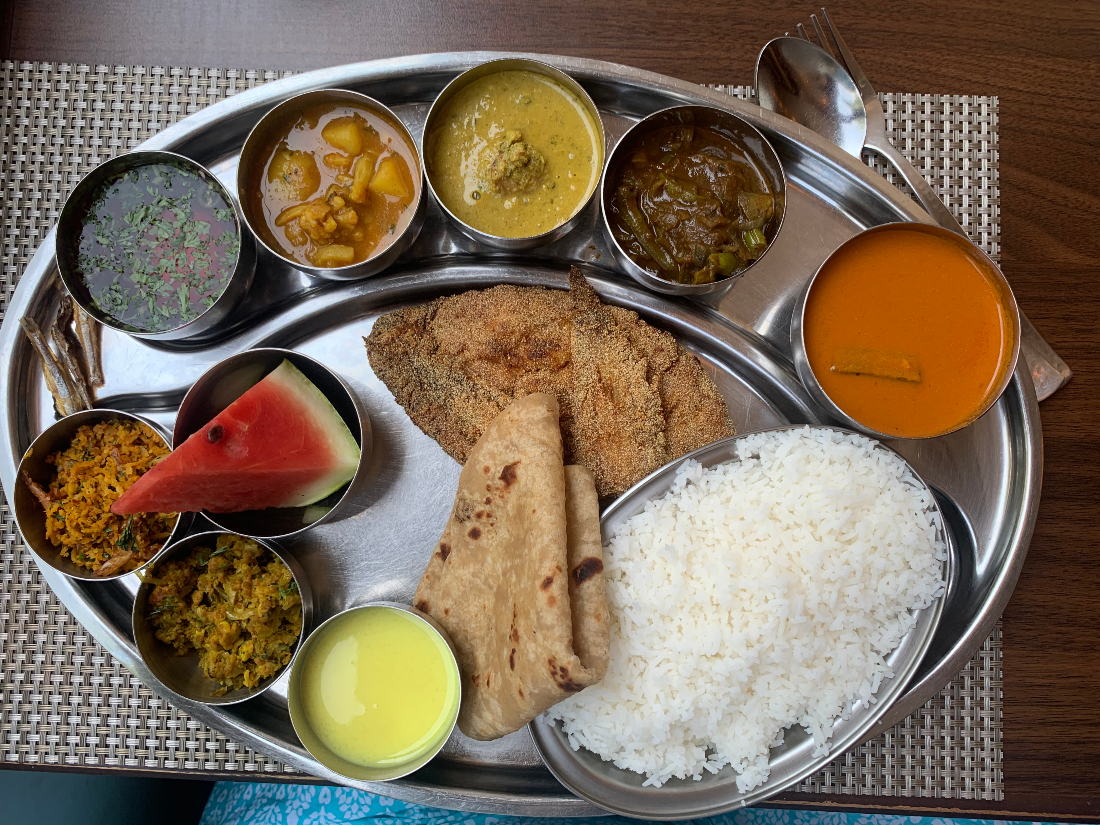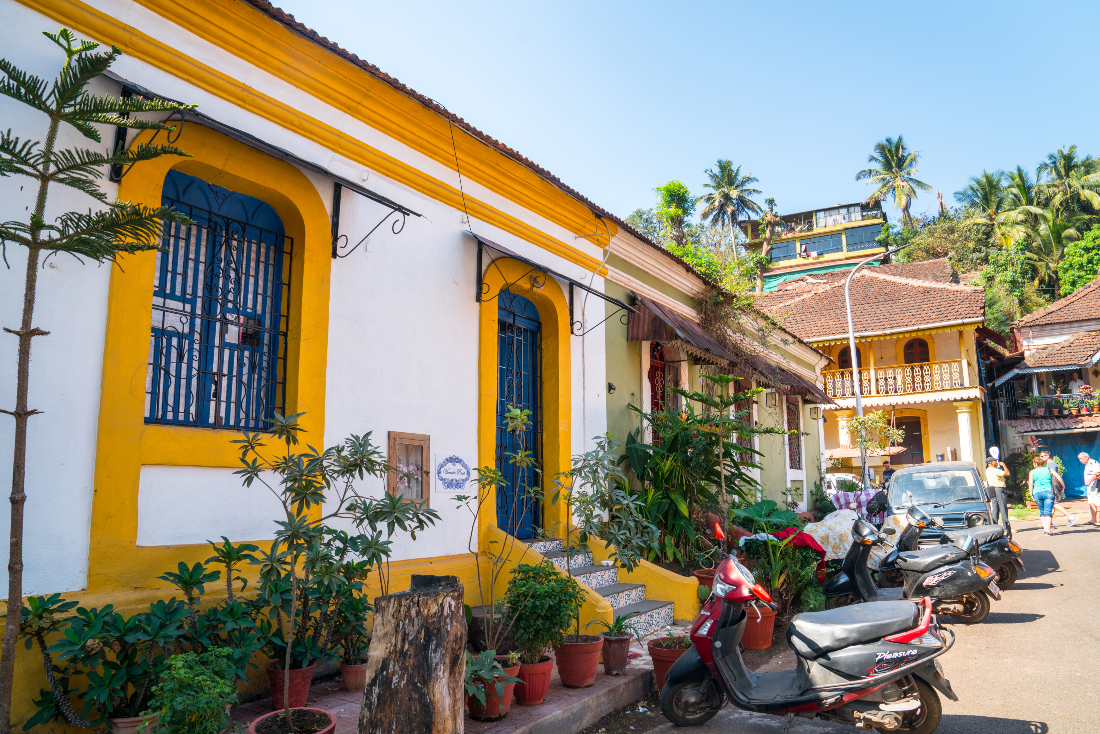


By Amandeep K
You’re sitting on a quiet beach, under a canopy of coconut trees swaying gently in the breeze. You’ve watched the sun rise over the horizon, painting the sky in vibrant hues. You woke up early and cycled through quiet villages, past green fields, and with just timid cows for company so that you could find that empty spot on the beach. You head for a swim, enjoying the cool, still waters. In an hour, you will be ravenous and will cycle to one of the beach shacks or to any of the cute little cafés nearby for breakfast.
You’ve done this the day before, and you can do it the next day. This is Goa, and living on the beach is part of the proverbial susegad life—an unapologetic, unhurried pursuit of peace and quiet—and you’re here for it.
One of India’s smallest states, Goa occupies a small part of its expansive western coast. The country’s favorite beach destination is the epitome of the good life: great food, cheap alcohol, stunning beaches, friendly people, and an appealing mix of the traditional and the modern.
Time, in Goa, is precious.

You can be the beach bum and spend your day eating fresh seafood, working on that perfect golden tan, enjoying foot massages, and even doing some shopping, all from a sunbed. The beaches up north — the popular Anjuna-Baga-Calangute belt or the Mandrem-Ashwem-Morjim stretch further north — are more vibrant, touristy, and with exciting food options. Meander down south to Agonda-Cola-Palolem to enjoy clean beaches, minus the crowd and tourists. Discover your own pocket of quiet on the rocky cliffs at Vagator, or at a lagoon in Cola Beach. All these beaches have shacks, with chairs or lounge beds in the sand, where you can spend the day sipping on local craft cocktails and eating fresh made-to-order seafood, fried in rava (semolina) or simmered in a coconut curry.
But wait, there’s more to Goa than just beaches. Leave the coast and travel inwards, exploring the forests of Mollem and jumping into a waterfall or two. Carry your binoculars and visit the plateaus and lakesides to find furry-winged friends. You can learn about the history of Goa via its various museums: the Museum of Goa, the boat-shaped Houses of Goa, the Big Foot that offers a glimpse into Goan life of yesteryears, or the ethnographic Goa Chitra Museum.
Tour the villages with local guides from Soul Travelling, Make It Happen, and Local Beat. They will tell you about village life and customs, the fascinating agricultural system, and importantly, Goan architecture. Goan houses have always been incorrectly termed Portuguese houses, but their style is unique to the state. Look out for the balconies (balcão) and impressive seating, the stucco patterns, the oyster shell windows, the red laterite stone walls, and other unique architectural expressions. See these on display at house tours: Figueiredo House, Casa Araujo Alvares, Braganza House, and Palacio do Deão.

Thrill-seeking adventure junkies can make the most of adrenaline-pumping activities such as kayaking in the mangroves or backwaters and coasteering, which involves climbing boulders, swimming, and trekking, with Adventure Breaks (@adventurebreaks). Learn a new skill such as surfing or stand-up paddling, bungee jump off Mayem Lake, or rent an e-bike and explore the islands of Chorao and Divar. For more exclusive and sustainable options, check out Khoj-aao! Adventures (@khojaao) and Terra Conscious (@terraconscious).
In the season, there are night markets and music festivals, gigs and comedy pop-ups, flea markets, and plant swaps.
If you don’t want to do any of this, just get out and go for a walk through the different villages. There’s architecture to view, rivers to walk along, a football match to watch, world-class yoga classes to explore, cutlet pao (beef patties with Goan bread) to be eaten at a street cart, and more.

The beauty of Goan food is how it marries local ingredients with colonial influences to create a cuisine that’s delicious, wholesome, and unusual. For a taste of some Portuguese treats, go to Figueiredo House, a 400-year-old aristocratic mansion where you can explore the museum, indulge in a multi-course meal of Portuguese fare, or even stay over. Lately, Goa has seen a marked increase in restaurants offering world cuisine, from Japanese yakitori to cigar lounges. Discover premium cocktails at the award-winning Tesouro or at For the Record Vinyl Bar. For the health-conscious, there are vegan and Keto menus. An authentic taste of Goa can be found at any of the fish thali (large assorted seafood platter) joints across the state. Down south, the Floating Feni Experience (@fazendacazulo) offers an introduction to the Goan liquor, feni.
Befitting its status as the preferred pandemic destination of the country, there are many cute cafés and restaurants that double up as co-working spaces. Work during the day, and wind down—just the spaces do—at night catching some live music, or quiz nights at the many new bars and refurbished tavernas.
Goa has two international airports, Dabolim and Manohar International Airport (MOPA). Use GoaMiles, the local taxi app, or bargain with the drivers already at the airport (rates start at $15). Later, you can rent a scooter ($5 a day) or a car ($15 a day) for the rest of your stay. Your hotel or Airbnb will help you with contacts.

There’s a roof for every kind of traveler, from hostels catering to the on-budget backpacker crowd to those looking for a luxurious escape. For the best experience, ditch the hotels and look for a nice villa with the same amenities and more privacy. In the touristy belt up north, there’s Summertime (villa rates start at $530) or the more Goan Villa Turiya ($33) in the south.
Accommodation by the beach is more expensive, with places like Palm Grove Beach Resort in Ashvem offering bungalows on the beach at $150 per night. For a secluded beach stay merely steps away from the ocean, choose between villas and tents at Elsewhere (@elsewheregoa) with prices starting at $134 and going up to $400 per night in peak season.

Peak season happens in pockets: February for Carnival, April-May for the summer rush, November-December for the Christmas season, and New Year.
Eating out is very affordable in Goa; street food and thali rates start at $2. The fancier places offer food starting from $5 and up, and drinks in the range of $6 to $10.


